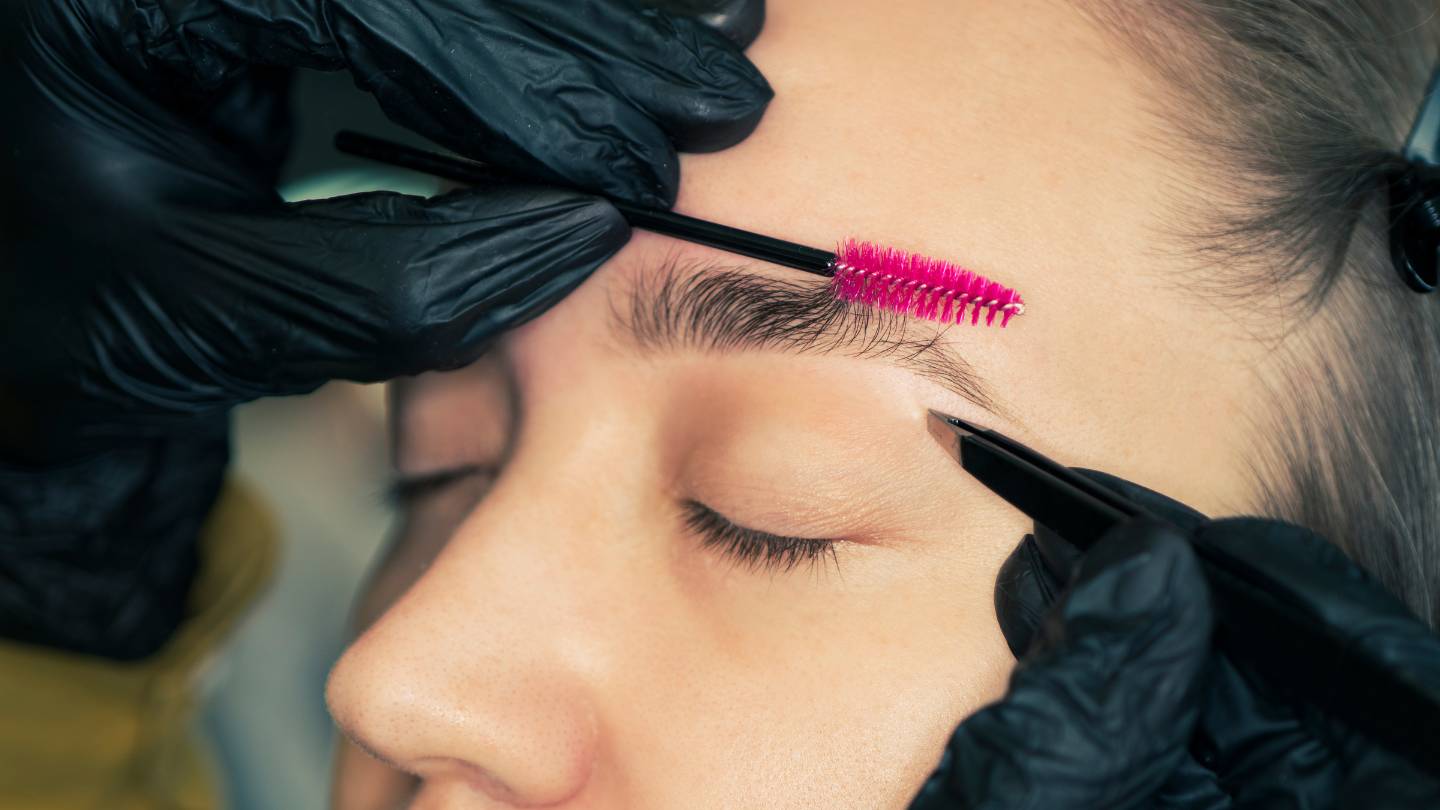Eyebrow feathering has become a popular cosmetic procedure for achieving natural-looking, full, and well-shaped brows. Whether you have sparse or uneven eyebrow hairs, eyebrow feathering offers a solution that can enhance your facial features while maintaining a natural appearance.
In this guide, we’ll cover everything from understanding eyebrow feathering to choosing the right technician and maintaining your new brows after the procedure.
Let’s get straight to the point
Eyebrow feathering is a semi-permanent cosmetic tattoo technique that uses fine hair-like strokes to create natural-looking, fuller brows. It offers a realistic appearance, low maintenance, and long-lasting results (up to 18 months).
The procedure involves minimal discomfort and works well for different skin types. Key considerations include selecting a skilled technician, proper aftercare (like avoiding sweat and sun), and potential issues like pigment retention on oily skin.
Though generally safe, improper procedures can cause risks like infection, allergic reactions, and uneven results. It’s ideal for those seeking fuller, well-shaped brows with minimal upkeep.
What Is Eyebrow Feathering?
Eyebrow feathering is a semi-permanent cosmetic tattoo procedure known as feather touch brows or feather tattoo eyebrows. It involves using a fine blade to create hair-like strokes that resemble natural eyebrow hairs.
Feathering produces soft and realistic brows, unlike traditional eyebrow tattoos, which can appear too sharp or artificial. This technique improves eyebrows’ shape, thickness, or fullness.
Benefits Of Eyebrow Feathering
Eyebrow feathering offers several advantages, including:
- Natural Appearance: The hair-like strokes blend seamlessly with your natural brows for a realistic look.
- Customisation: The procedure allows for tailored shaping and colouring that matches your style and facial features.
- Time-Saving: Feathered brows eliminate the need for daily brow makeup, saving time in your morning routine.
- Low Maintenance: Once healed, feathered eyebrows require minimal upkeep.
- Long-Lasting Results: Feathered brows can last up to 18 months with proper care.
- Suitable for Different Skin Types: Feathering works well for various skin types, including oily and sensitive skin.
- Less Invasive: Compared to microblading, eyebrow feathering causes less skin trauma and a lower risk of scarring.
Key Considerations With Eyebrow Feathering
If you’re considering eyebrow feathering, it’s important to understand the process and how to prepare for it. Here are the steps involved:
1. Find A Qualified Technician
Choosing a skilled and experienced technician is crucial for achieving the best results. Look for professionals who specialise in eyebrow feathering and have a proven track record.
It’s a good idea to schedule a consultation beforehand to discuss your desired look and ensure the technician understands your preferences.
2. Brow Analysis
During your consultation, the technician will assess your current brows and determine the most suitable technique for your needs. Some suggest a combination of shading and microblading for optimal results.
Microblading involves using a handheld tool to create individual strokes, while shading adds depth and a soft finish.
3. Preparation For The Procedure
Before your appointment, it’s important to follow any pre-treatment instructions provided by your technician. These may include avoiding sun exposure, certain skin products, or activities that could irritate your skin.
On the day of the procedure, ensure your face is clean and free of makeup or lotions.
Eyebrow Feathering Procedure
The actual process of eyebrow feathering involves the following steps:
1. Application Of Pigment
The technician inserts pigment into the skin using a sterile, fine needle, creating the appearance of natural hair strokes. The process is typically painless, though some clients may feel mild discomfort.
A numbing cream can be applied beforehand if needed.
2. Shaping And Defining The Brows
After the initial strokes, the technician will shape and define the brows according to the custom design mapped out during your consultation.
The pigment is carefully blended to ensure a natural look, filling in sparse areas and enhancing the brow’s shape.
3. Healing Process
After the procedure, your eyebrows will undergo a healing phase. It’s normal for them to appear darker at first, but the colour will soften over the following days as the skin heals.
Maintenance And Aftercare
Proper aftercare is essential to ensure the longevity of your eyebrow feathering results. Here are some important tips for maintaining your brows:
1. Avoid Sweating And Sun Exposure
For at least a week after the procedure, avoid activities that cause excessive sweating, such as going to the gym, saunas, or steam baths. It would also help if you avoided direct sunlight, tanning beds, and swimming in chlorinated or saltwater pools for about two weeks.
2. Use Gentle Skincare
Cleanse the brow with mild soap and lukewarm water twice daily during the healing process. Avoid rubbing or touching the brows with your fingers.
Applying a thin layer of a special cream or ointment provided by your technician will help moisturise the area and reduce the risk of infection.
3. Protect Your Brows With Sunscreen
After the healing process, apply sunscreen to your brows daily to protect the pigment from fading due to sun exposure.
4. Schedule A Follow-Up Appointment
A touch-up appointment is typically recommended 4 to 8 weeks after the initial procedure. This session allows your technician to perfect areas where the pigment may not have settled evenly and ensures your brows look their best.
Common Issues With Eyebrow Feathering
While eyebrow feathering is generally a safe and effective procedure, there are a few common issues to be aware of:
1. Pigment Retention On Oily Skin
Individuals with oily skin may experience challenges with pigment retention, as the natural oils in the skin can cause the pigment to fade more quickly. Your technician may recommend additional touch-ups or a combination of feathering and shading techniques to address this.
2. Avoiding Skin Irritants
Using skincare products with active ingredients like retinoids or alpha hydroxy acids (AHAs) before or after the procedure can affect how well your skin retains the pigment. Avoiding these products for some time before and after the treatment is important.
3. Contraindications For Pregnant Or Nursing Women
Eyebrow feathering is not recommended for women who are pregnant or breastfeeding, as the procedure may pose risks to both mother and child.
4. Bleeding During The Procedure
Some clients may experience mild bleeding during the procedure, particularly if they are on blood thinners or have underlying health conditions that affect bleeding. It would help to inform your technician of any medications you take before treatment.
Potential Risks And Side Effects
As with any cosmetic procedure, there are potential risks and side effects associated with eyebrow feathering. These include:
- Infection: As the procedure involves breaking the skin, there’s a small risk of infection if proper aftercare isn’t followed.
- Allergic Reactions: Some individuals may be allergic to the pigments used in eyebrow feathering. It’s important to discuss any known allergies with your technician before the procedure.
- Scarring: In rare cases, improper technique or inadequate aftercare can lead to scarring.
- Uneven Colour or Shape: Choosing an inexperienced technician increases the risk of uneven brows. This can be avoided by selecting a qualified professional.
Should You Consider Eyebrow Feathering?
Eyebrow feathering is an excellent option for individuals with sparse, thinning, or greying eyebrows. Many people choose feathering to enhance their appearance, regain confidence, and simplify their beauty routine.
Causes Of Thinning Eyebrows
Eyebrow hair thinning can result from various factors, such as:
- Over-Plucking or Waxing: Excessive tweezing or waxing can lead to permanent eyebrow hair loss.
- Ageing: Our hair—including eyebrow hair—naturally thins out and may turn grey or white.
- Nutrient Deficiency: A lack of essential vitamins and minerals like biotin, vitamin D, and iron can lead to hair loss, including eyebrows.
Eyebrow Feathering: A Long-Term Solution
Arrow feathering offers a long-term solution if you’re tired of using brow pencils or powders daily. With proper care, feathered brows can last up to 18 months, giving you a polished, natural look without needing constant maintenance.
Conclusion
Eyebrow feathering is a safe, semi-permanent way to achieve beautifully arched, natural-looking brows. Whether you’re looking to fill in sparse areas or completely reshape your brows, this procedure can help you achieve the desired look with minimal effort.
By selecting a skilled technician, following proper aftercare, and maintaining regular touch-ups, you can enjoy flawless, low-maintenance brows for over a year.
Eyebrow feathering is a worthwhile investment for anyone seeking to enhance their natural beauty and boost their confidence with perfectly shaped brows.
FAQs About Eyebrow Feathering
Will My Feathered Brows Stay Put All Day?
Using a long-lasting or waterproof eyebrow product and setting it with brow gel can help maintain the look throughout the day.
Are there any special tips for beginners attempting to feather?
Start with light strokes and gradually increase the intensity to avoid overdoing it. Practice on a small area first to get comfortable with the technique.
Can I Still Use Stencils For Feathering My Brows?
While stencils can provide guidance, feathering typically involves a more freehand approach to create a natural look.
Is It Necessary To Blend My Feathered Brows?
Yes, blending with a spoolie brush or clean finger helps soften the strokes and create a seamless, natural appearance.
How Often Should I Feather My Brows?
The frequency depends on your brow growth and personal preference. Some may need daily maintenance, while others require less frequent touch-ups.


